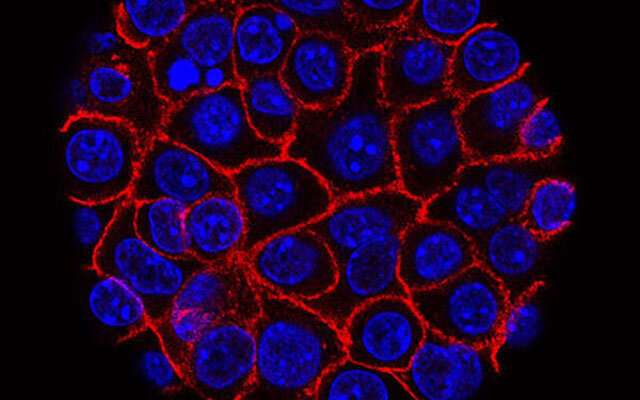
Pancreatic cancers are among the most aggressive, deadly tumor types, and for years, researchers have struggled to develop effective drugs against the tumors. Now, Salk Institute researchers have identified a new set of molecules that fuel the growth of tumors in pancreatic ductal adenocarcinoma (PDAC), the most common type of pancreatic cancer.
The new research, published in Nature Communications, explains how certain gene mutations trigger out-of-control growth in pancreatic cancer by activating a “super-enhancer” that turns on other genes. It also showed the effectiveness of a new drug that put the brakes on pancreatic cancer growth by blocking the effects of that super-enhancer.
“This is the first time anyone has looked in such detail at the role of super-enhancers in pancreatic cancer,” says senior author and Salk Professor Ronald Evans, director of Salk’s Gene Expression Laboratory. “The discovery of this super-enhancer gives us both basic insight into PDAC and a new way to think of therapies.”
Enhancers are regions of DNA, that when bound by proteins, boost the expression of genes. This results in higher levels of those genes’ protein products. Super-enhancers are the most active type of enhancer, and they can be identified by their unique molecular tags. Because super-enhancers can simultaneously and powerfully activate many genes, they can rapidly change the state of a cell, switching on cellular programs to encourage rapid growth or change the cell’s identity, for instance.
In the new work, Evans’ team analyzed 16 different human pancreatic cancer cell lines and identified hundreds of different super-enhancers. They pinpointed one, associated with the gene hnRNPF, that was far more active in pancreatic cancer cells than healthy cells. Then, through a series of experiments, the group showed how hnRNPF sets off a cascade of events leading to an increase in the amounts of overall proteins cells were producing.
“It’s well-established that cancer cells upregulate protein production in order to fuel their rapid growth,” says first author Corina Antal, an assistant professor of pharmacology at UC San Diego School of Medicine who led the work as a postdoctoral researcher in Evans’ lab. “We have now identified how cells regulate this process at the super-enhancer level.”
The researchers went on to demonstrate that by deleting the super-enhancer or the hnRNPF gene in the cell lines, they could slow the growth of pancreatic cancer cells by more than 80%.
They also found that an experimental drug targeting Prmt1, one of the proteins impacted by hnRNPF activation, could stop the growth of isolated pancreatic tumors in the lab and the growth of pancreatic tumors in mice.
“We were excited to find that there’s not a lot of redundancy in this super-enhancer pathway, which means there might be multiple ways to impact it with therapeutics,” says Michael Downes, a senior staff scientist at Salk. “If you disrupt this network at any point, you have the same effect on blocking cellular growth.”
Additionally, the team discovered that Myc, a cancer-related gene that is mutated in many cancers, including pancreatic cancer, can activate the hnRNPF super-enhancer. Drugs effectively blocking Myc have been hard to develop, and the new results suggest a completely different way of stopping the effects of these Myc mutations—by targeting the pathway turned on by the super-enhancer.
Finally, the researchers tested cells from a patient with pancreatic cancer and found that the hnRNPF super-enhancer was active in these cells.
“These results clearly demonstrate that this super-enhancer is relevant in humans and could even be used as a marker to monitor pancreatic cancer progression,” says Evans, March of Dimes Chair in Molecular and Developmental Biology.
More work is needed to discover whether drugs targeting the super-enhancer or related molecules might be useful for treating pancreatic cancer in patients.
More information:
A super-enhancer regulated RNA-binding protein cascade drives pancreatic cancer, Nature Communications (2023). DOI: 10.1038/s41467-023-40798-6
Journal information:
Nature Communications
Source: Read Full Article


